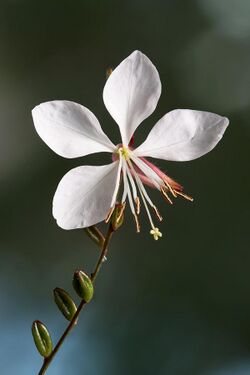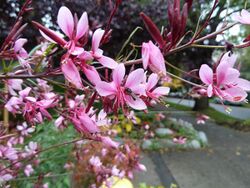Biology:Gaura lindheimeri
| Oenothera lindheimeri (Gaura lindheimeri) | |
|---|---|

| |
| Gaura lindheimeri 'Whirling Butterflies' | |
| Scientific classification | |
| Kingdom: | Plantae
|
| (unranked): | |
| (unranked): | |
| (unranked): | |
| Order: | |
| Family: | |
| Genus: | |
| Species: | O. lindheimeri
|
| Binomial name | |
| Oenothera lindheimeri (Engelm. & A.Gray) W.L.Wagner & Hoch
| |
| Synonyms | |
|
Gaura lindheimeri Engelm. & A.Gray | |
Oenothera lindheimeri,[1][2] formerly Gaura lindheimeri, and commonly known as Lindheimer's beeblossom, white gaura, pink gaura, Lindheimer's clockweed, and Indian feather, is a species of Oenothera.
The perennial plant is native to southern Louisiana and Texas .[3][4] The specific epithet is after Ferdinand Jacob Lindheimer, a German-born botanist who collected extensively in Texas for Harvard University professor Asa Gray.
Description
Oenothera lindheimeri is a perennial herbaceous plant growing to 50–150 cm tall, with densely clustered branched stems growing from an underground rhizome. The leaves are finely hairy, lanceolate, 1–9 cm long and 1–13 mm broad, with a coarsely toothed margin.
The flowers are produced on a 10–80 cm long inflorescence; they are pink or white, 2–3 cm diameter, with four petals 10–15 mm long and long hairlike stamens, and are produced from the beginning of spring until the first frost.[5][6]
Cultivation
Oenothera lindheimeri is commonly grown as an ornamental plant. It is used in either garden beds or pots for accent colour and a delicate texture. It grows best in full sun and can survive lengthy periods of drought.
Several cultivars have been selected for varying flower color, from nearly pure white in 'Whirling Butterflies' to darker pink in 'Cherry Brandy' and 'Siskiyou Pink'. In some, the petals are white at dawn then turning pink before falling off at dusk.
Although a perennial rated USDA Zone 5(6)-9 for hardiness it may not overwinter reliably, and is often treated as an annual outside its native areas. In colder climates a heavy winter mulch is necessary.[7]
This plant has gained the Royal Horticultural Society's Award of Garden Merit.[8][9]
Etymology
Gaura: Derived from Greek, meaning ‘superb’. Named in reference to the stature and floral display of some species in this genus.[10]
Lindheimeri: Named for Ferdinand Lindheimer (1801–79), who discovered the plant Lindheimera texana.[10]
References
- ↑ ITIS Standard Report Page: Oenothera lindheimeri . accessed 8.1.2013
- ↑ Updated for ITIS by the Flora of North America Expertise Network, in connection with an update for USDA PLANTS (2007-2010)
- ↑ {{citation | mode = cs1 | title = Gaura lindheimeri | work = Germplasm Resources Information Network (GRIN) | url = | publisher = [[Organization:Agricultural Research ServAgricultural Research Service (ARS), United States Department of Agriculture (USDA) | access-date = 10 January 2018 }}
- ↑ USDA Plants Profile: Gaura lindheimeri
- ↑ Munz, P. A. (1938). Studies in Onagraceae XI. A Revision of the Genus Gaura. Bull. Torrey Bot. Club 65: 105-122, 211-228.
- ↑ Huxley, A., ed. (1992). New RHS Dictionary of Gardening. Macmillan ISBN:0-333-47494-5.
- ↑ Perennials.com
- ↑ "Oenethera lindheimeri". Royal Horticultural Society. https://www.rhs.org.uk/Plants/386413/Oenothera-lindheimeri-(G)/Details.
- ↑ "AGM Plants - Ornamental". Royal Horticultural Society. July 2017. p. 39. https://www.rhs.org.uk/plants/pdfs/agm-lists/agm-ornamentals.pdf. Retrieved 27 February 2018.
- ↑ 10.0 10.1 Gledhill, David (2008). "The Names of Plants". Cambridge University Press. ISBN:9780521866453 (hardback), ISBN:9780521685535 (paperback). pp 175, 238
External links
Wikidata ☰ {{{from}}} entry


